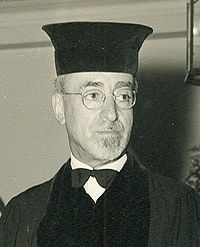- David de Sola Pool
-
David de Sola Pool
(Hebrew: דוד די סולה פול)
de Sola Pool (unknown date).Position Rabbi Synagogue Congregation Shearith Israel
New York City, New York, United StatesBegan 1907 Personal details Born 1885
London, England, United KingdomDied 1970 (aged 84–85) Spouse Tamar (née Hirschensohn) de Sola Pool Children Ithiel de Sola Pool (1917–1984) Occupation • Rabbi
• WriterAlma mater Hildesheimer Rabbinical Seminary
Berlin, GermanyDavid de Sola Pool (1885–1970) (Hebrew: דוד די סולה פול) was an American rabbi and writer.
Contents
Early life and education
He was born in London, England, and later received his rabbinic ordination from the Hildesheimer Rabbinical Seminary, located in Berlin, Germany.
Career
In 1907, de Sola Pool was invited to become the minister of Congregation Shearith Israel — often called the Spanish and Portuguese Synagogue — located in New York City, New York. The oldest Jewish congregation in the United States,[citation needed] he served as its minister for sixty-three years.
De Sola Pool translated and edited the Sephardic prayer book for the Union of Sephardic Congregations and the Ashkenazic prayer book for the Rabbinical Council of America. He also wrote a book The Kaddish (1929), a well-regarded work[by whom?] on the origins of the Kaddish prayer. In addition, de Sola Pool wrote a book Why I am a Jew (1957).
American Jewish Historical Society
He was a president of the American Jewish Historical Society, located in New York City.
de Sola Pool wrote several books about Jewish history in Colonial America including Portraits Etched In Stone — Early Jewish Settlers, 1682–1831 (1952) and together with his wife, Tamar de Sola Pool, An Old Faith in the New World — Portrait of Shearith Israel, 1654–1954 (1955).
Personal life
His wife, Tamar, was the daughter of Chaim Hirschensohn.
His son, Ithiel de Sola Pool, was a pioneer in the development of social science and founder of the political-science department at the Massachusetts Institute of Technology, located in Cambridge, Massachusetts. His daughter, Naomi de Sola Pool, was a physician.
Richard (Dick) Rodstein, his grandson, is a voice-over announcer.
Bibliography
- de Sola Pool, David (1929). The Kaddish. Bloch Publishing (New York City, New York). OCLC 6991992.
- de Sola Pool, David (1952). Portraits Etched in Stone — Early Jewish Settlers, 1682–1831. Columbia University Press (New York City, New York). OCLC 424980.
- de Sola Pool, David; de Sola Pool, Tamar (1955). An Old Faith in the New World — Portrait of Shearith Israel, 1654–1954. Columbia University Press (New York City, New York). OCLC 1172838.
- de Sola Pool, David (1957). Why I Am a Jew. Thomas Nelson (New York City, New York). OCLC 652382.
References
- de Sola Pool, David; Angel, Marc D. (editor) (1980). Rabbi David de Sola Pool — Selections from Six Decades of Sermons, Addresses, and Writings. Union Of Sephardic Congregations (New York City, New York). ISBN 978-0-814-80753-8.
Categories:- 1885 births
- 1970 deaths
- 20th-century rabbis
- 20th-century Sephardi Jews
- American Orthodox rabbis
- American Sephardic Jews
- American sermon writers
- American translators
- English emigrants to the United States
- English Jews
- Jewish American historians
- People from London
- Spanish and Portuguese Jews
- Writers from New York City
Wikimedia Foundation. 2010.
